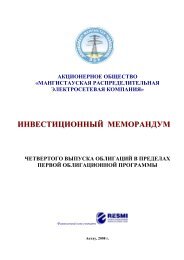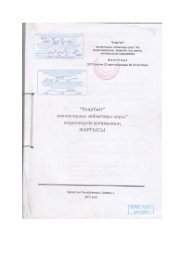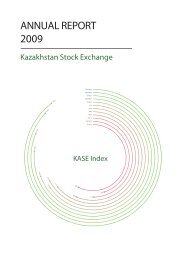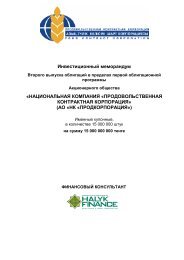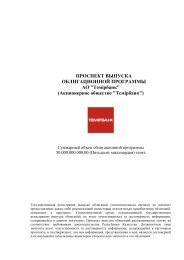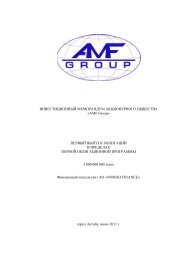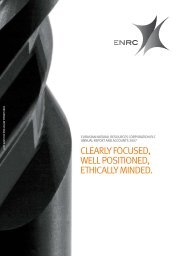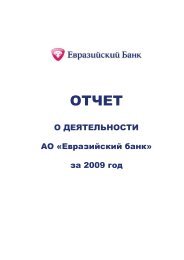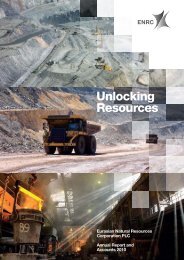JPMorgan - KASE
JPMorgan - KASE
JPMorgan - KASE
Create successful ePaper yourself
Turn your PDF publications into a flip-book with our unique Google optimized e-Paper software.
As a result of these discussions, HKM will install a 55-megawatt electrical power plant in the<br />
Kumkol field to use associated gas from the Kumkol South, South Kumkol and Kumkol North<br />
fields. It is anticipated that the cost of construction of the plant will be approximately<br />
$32 million. This cost will be shared with our Turgai Petroleum joint venture. It is intended that<br />
the plant will provide stable electrical power for field operations and will provide excess<br />
electricity for sale to Kyzylorda city and a credit for Shymkent refinery power usage. Engineering<br />
and construction are underway and the plant will be completed in the second quarter of 2003. In<br />
addition, as a joint venture partner in the Akshabulak fields, we are participating in a project to<br />
provide natural gas to the Kyzlorda region.<br />
When we begin exploration activities in a new field, at certain stages in the development of the<br />
field and every five years during the operation of the field, we must perform environmental<br />
impact assessments. We must also provide, every five years, the documentation demonstrating<br />
that we do not exceed applicable maximum allowable limits on emission to the atmosphere. The<br />
annual cost incurred in connection with these assessments varies from year to year, depending<br />
upon our exploration and development activities in that year.<br />
We are not currently subject to significant expenditures in connection with the remediation of<br />
contaminated sites. The HKM acquisition agreement, as well as Kazakhstan’s privatisation law,<br />
allocates financial responsibility for environmental damage which occurred prior to the date we<br />
acquired HKM to the Kazakhstani government. Therefore, we are responsible only for<br />
environmental damage which has occurred in connection with our operations since December<br />
1996. In 1997, we hired Golder Associates, Ltd. to perform a baseline study of environmental<br />
damages to the properties acquired in the HKM acquisition. The Kazakhstani government has<br />
reviewed and approved the results of the phase one environmental site assessment. Local<br />
environmental consultants, Ecotera LLP, have finalized the results of the baseline study and<br />
performed the Ecological Monitoring stipulated by Order 340-P of the Ministry of Natural<br />
Resources and Environmental Protection of the Republic of Kazakhstan. We have identified some<br />
environmental damage that occurred before our acquisition of HKM. We believe that the<br />
Kazakhstan government will be responsible for those damages as provided for in the HKM<br />
acquisition agreement and the Kazakhstan privatization laws.<br />
To date, there have been no significant releases of contaminants under our operation of the<br />
Kazakhstani oil fields. We could incur significant liability for damages, clean-up costs and/or<br />
penalties in the event of certain discharges into the environment or environmental damage<br />
caused by non-compliance with environmental laws or regulations which occurred after we<br />
acquired HKM. Any environmental liability with respect to our production activities could<br />
materially adversely affect our financial condition and results of operations.<br />
Refining Operations<br />
Similarly to our Upstream oil and gas operations, we pay environmental user fees for our<br />
Downstream operations based on the volumes of pollutants we generate. The fees are generally<br />
not material for emissions for which we possess emissions permits. However, fines can be<br />
multiplied by as much as 15 times the normal environmental user fee for those emissions for<br />
which we do not have permits. We believe that all material permits required for the operations<br />
of the Shymkent refinery are in place.<br />
Kazakhstani regulations specify that a refinery should be built with a minimum protection zone<br />
of one kilometre from human habitation. The Shymkent refinery is located in the city of<br />
Shymkent’s industrial zone five km southeast of the residential district.<br />
The crude and light oil product tanks at the Shymkent refinery are equipped with pontoons and<br />
floating roofs that reduce hydrocarbon emissions more effectively than fixed roof reservoirs. The<br />
system of oil traps and separation ponds with skimmers is designed to prevent the leakage of<br />
harmful substances and permit re-refining of recovered oil. The system returns treated water to<br />
83




